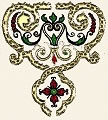|
|
 |
Female
Baroque Clothing
|
 |
During the
reign of Louis XIV, the Sun King, French fashion took over the leading
role in Europe. This was caused by France having developed into
the main political and cultural power, thus turning French fashion
into an equally "absolutistic" regime. During the period from 1660
onwards, fashion in France, according to the absolutistic ideal,
became rigid, ordered and strict in its do's and don'ts of etiquette.
About 10 years
after Louis XIV's accession to the throne and maturity in the year
1661, the entirety of Europe was under the dictatorship of the French
royal fashion in about 1670. From that date on European rulers strove
to imitate the powerful Sun King, they even lost national differences
and diversities in fashion, thus French fashion became world fashion.
After the Thirty
Years War, when the English King Charles I had been executed and
the Puritans under Cromwell reigned; when Louis XIV was still merely
a child at the signing of the Peace of Westphalia; when the numerous
municipalities of Germany were in ashes and ruins after the horror
of the 30s Years War and possessed neither a political nor a cultural
centre; when the Spanish and Austrian rulers were still clinging
to the old fashioned Spanish court costumes of the 16th century;
there was no court in Europe left who could possibly take over the
leading role in fashion. Thus a different type of model was looked
upon in the 1650s and 60s. The Netherlands, and particularly the
rich, powerful and independent Burghers. There are numerous
paintings of the 1640s-1660s by Dutch artists of every day life
scenes amongst the Dutch upper middle class, which you will find
in the Period
Images chapter under Dutch
Paintings. The clothing of the Dutch was now made of colourful
velvets and silks, decorated with many ribbons.

1630-1660
Female fashion
changed tremendously from the 1630s towards the 1660s. The entire
silhouette changed completely, from the high waisted gowns of the
1630s to the slender and long waisted ones of the 1660s.
During this period gowns were generally made with bodices and skirts
seamed together at the waist which was slightly elevated. Gowns
opened at centre front. The outer layer was worn over an underbodice,
a boned, stiffened garment like a corset that had a long, V-shaped
section called a stomacher at the front. This stomacher filled in
the upper part of the gown. The sleeves were often very full on
gowns and fashionable jackets. They were puffed out, frequently
paned. Contemporary writers refer to stylish sleeves, paned out
and tied with ribbons into a series of puffs as virago sleeves.
The neckline was usually low, some V-shaped and some square, some
horizontal in shaping. Stiff ruffs had been now replaced by falling
ruffs, gathered collars tied under the chin with strings. Large
neckerchiefs were seen as well. Horizontal necklines were often
edged with a wide, flat collar.

1660-1680
The gowns
changed considerably in shaping and silhouette. The bodice was
lengthened and narrowed, so that it became long-waisted and more
slender with an extended V-shaped point at the front. The necklines
tended to be low, wide and horizontal or oval in shape and were
frequently edged by a wide lace collar or band of linen called
a whisk. The sleeves were set low on the shoulder, opening into
a full ruff that ended below the elbow.
While petticoat breeches were fashionable during the 1650s and
1660s, the ladies at the French court were looking towards Holland
for fashionable advice, while in England King Charles II was still
in exile and the protectorate under Cromwell and the Puritans
kept fashion rather dull and plain anyway. Strangely enough, it
seems as if female fashion was more restricted in its lavishness
and perhaps even ridicule regarding decorations, ribbons and such,
than male fashion, being less extravagant, and actually very elegant
and rather simple in the 1660s.
The the upper
skirts extended in the back to a train, and just like back in the
middle ages the length of the train denoted a lady's rank at the
French court. The waist became extremely small again, and often,
so some chroniclers stated, a young woman was only then satisfied
when she could span her slender waist with her own two hands. The
corset became again, similar to what it looked like during the late
16th century, at the time of the Spanish high fashion, very long
in the front, ending in the middle in an extended piece, which was
extra rigid, usually achieved by whalebone. And yet, there was a
big difference between the French female fashion of the second half
of the 17th century and the Spanish fashion of the century earlier,
because now the silhouette and the garments were no longer concealing
the female figure and body, but instead accentuating its beauty.
This was the age of the Maitresse, and every gentleman who wanted
to be taken seriously, was supposed to have at least one Maitresse
en titre. Monogamy within the marriage was thought to be only
suitable for the commoners. But it was frowned upon, if an aristocrat
took a maitresse who was not noble, though the most famous example
probably comes from England, namely Nell Gwynn, King Charles II's
Mistress, who had been an actress. Before that she was actually
an 'Orange Girl', a euphemism for a prostitute on the streets and
in the theatres, to be very blunt. Nevertheless, Restoration England
was more free than France under Louis XIV, and although Charles
could never ennoble Nell, his surviving children with her were ennobled.
Thus 'Pretty Witty Nell's son became the Duke of St. Albans. It
is being said, that she was meant to be made the Countess of Greenwich,
but alas, Charles died before that.

1680-1700
The now fashionable
gown evolved gradually from those prevalent between 1660 and 1680,
and it showed the following features: The neckline revealed less
bosom now and became more square, which might have been a result
of Madame de Maintenon's influence on Louis XIV and the French
court, who was very conservative and religious. The corsets were
now visible at the front of the bodice, heavily decorated, and
ending in a pronounced V at the waist. Separate stomachers could
be tied or pinned to the front of the corset to vary the appearance
of a dress.
This is also
the time, when a new dress for women emerged: the Mantua or Manteau. Instead of cutting the bodice and shirt as
separate pieces that were sewn together, bodice and skirt were
cut in one length from shoulder to hem. Cut to fall in back and
front, the garment was worn over a corset an an undershirt, a
chemise. For casual wear it was loose, but for more formal wear
it was pleated to fit the body at front and back and also belted.
Front skirt edges were often pulled back and fastened to form
a draped effect.
The corset, which had been designed to hide all female curves
during the reign of the Spanish fashion, was now meant to accentuate
them, and gained more and more importance. The bodice, which fitted
the corset exactly in cut and form, was usually only held together
at the waist, and the gap in between was filled with a beautifully
decorated stomacher. The corset could also be worn without the
bodice, in this case there would be sleeves directly laced onto
and fastened to the corset, which was made of exquisite fabrics
and was decorated usually with ribbon bows. Many corsets had on
their stomacher several rows of ribbon bows, the so-called Echelles,
which became bigger from the waist up to the decolleté,
like the steps of a ladder.
The decolleté
was a very important factor as well. It wasn't any longer hidden
underneath the rigid tight lacing of the 16th century, nor underneath
neckerchiefs or lace collars, but instead were rather wide and
low. At first cut in an oval, and later on almost straight. The
lace collar, which had covered the decolleté before, started
to get lost already around the middle of the century and shrunk,
when large lace collars went out of fashion, to a decorative edging,
the so-called bertha, which followed the neckline. The
collar was not to come back into female fashion for a long time
afterwards.
The sleeves
became shorter as well, now reaching often only down to the elbows.
Now, that the decolleté was cut lower and the sleeves became
shorter, the chemises gained tremendously in importance. The neckline
of the chemise was now decorated with lace, and so were the sleeves,
laces elegantly flowing around the lower arms in lavish abundance.
Though in France, when Louis XIV grew old and went more and more
under the influence of his Maitresse or perhaps even morganatic
wife, Madame de Maintenon, the court returned back to more covering
clothing, with the king taking over the bigotry and piety of Madame
de Maintenon. The decolleté was higher once again, became
smaller, the sleeves lengthened often down below the elbows, with
the lavish and broad lace ruffles covering most of the rest of
the lower arm and wrist anyway.
The ladies'
skirts at Louis XIV's court seemed to be designed for representation.
The upper skirt, which was called robe or manteau or earlier, modeste, ended in a train, and its length was
determined by the status of the wearer. In an edict from 1710
there is a clear description of the different length of the train.
For example: the train of the Queen of France was 11 feet long,
those of the Princesses, the daughters of the royal house, 9 feet.
Further relations were allowed 7 feet, like cousins, for example,
Princesses who were not daughters of the King 5 feet, and Duchesses
3 feet.
The ladies'
dresses were, just like the men's suits, made from heavy fabrics
like silks, brocades and velvets. The fabrics had bright colours,
and in the beginning they were plain, later on patterned, especially
with stripes or with flower patterns. But although those court
dresses were designed for representation, they still accentuated
the female figure. The upper skirt, the robe or manteau, was slit
in the front and draped back, in the 1670s this drapery was still
held gracefully with one arm or by a young page, soon to be fastened
with jewelled dress fasteners. The manteau, which was draped on
the hips, was supported by artificial round shapes at the back
of the wearer, the so-called bouffantes, while the waist
was extremely small, and all the fabric of the under skirt, the jupe or petticoat and the overskirt being gathered. Thus
the female figure seemed, despite the masses of fabric being used,
to be more bared than actually covered.
The manteau was most of the time made from the same fabric as the bodice,
therefore creating an harmonious unit. The jupe, which
was usually made from a different colour and pattern, was also
done in valuable, heavy fabrics, and decorated with broad braids
or laces, volants and frills, clearly visible in the front underneath
the draped back manteau. During the 1660s there was also
black lace coming into fashion in France, to be used for such
decorations as well, but it was usually used for winter garments,
and was also called 'winter lace'.
The coat was
almost completely absent from female fashion, especially since the
manteau was always lined and thus provided a good protection against
cold in winter. Therefore even during the cold season usually only
a large shawl was worn, or a short cloak, or a large fur round shaped
collar. To protect the lower arms long gloves which reached up to
the elbows were worn or a muff was worn.

Female
Costumes
Ladies' Baroque Clothing
Indoor
Garments | Footwear | Accessories | Hairstyles | Head-dresses | Development
of the Fontange
Hairstyles
by Vermeer | Dress
Colours by Vermeer | Head-dresses
by Vermeer
Costume Focus Headwear & Neckwear | Costume
Focus Working Women
Costume
Focus Children's Clothing
Ladies'
Costume Quotes
Male
Costumes
Gentlemen's
Baroque Clothing
Indoor
Garments | Footwear | Accessories | Hairstyles | Head-dresses
Costume
Colours by Vermeer | Hair-
and Head-dresses by Vermeer
Gentlemen's
Costume Quotes
~ ~ ~ ~ ~ ~ ~ ~ ~ ~ ~ ~ ~
Embroidery Gallery | Gallery of Needlework
Engravings
Lace Gallery &
Identification | Glossary
Contents © N. Kipar 1997 |









